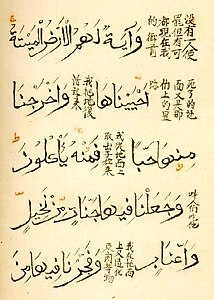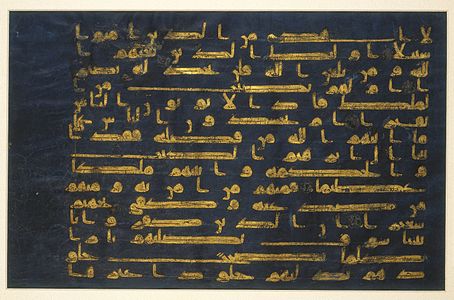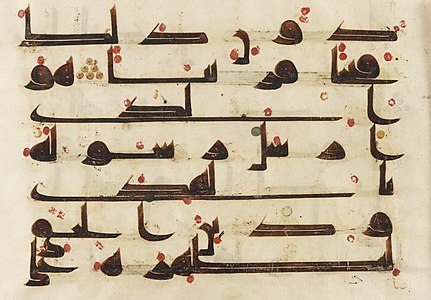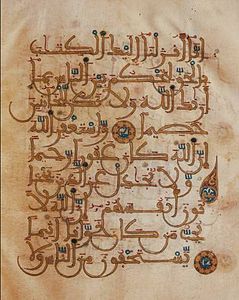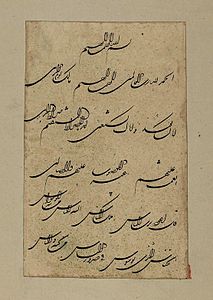Quran
| Quran | |
|---|---|
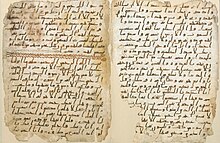 Two folios of the Birmingham Quran manuscript, an early manuscript written in Hijazi script likely dated within Muhammad's lifetime between c. 568–645 | |
| Information | |
| Religion | Islam |
| Language | Classical Arabic |
| Period | 610–632 CE |
| Chapters | 114 (list) See Surah |
| Verses | 6,348 (including the basmala) 6,236 (excluding the basmala) See Āyah |
| Full text | |
The Quran,
Muslims believe that the Quran was orally revealed by God to the final Islamic prophet Muhammad through the archangel Gabriel incrementally over a period of some 23 years, beginning on the Night of Power, when Muhammad was 40, and concluding in 632, the year of his death at age 61–62. Muslims regard the Quran as Muhammad's most important miracle, a proof of his prophethood, and the culmination of a series of divine messages starting with those revealed to the first Islamic prophet Adam, including the Islamic holy books of the Torah, Psalms, and Gospel.
The Quran is believed by Muslims to be not simply
The Quran assumes the reader's
| Quran |
|---|
Etymology and meaning
The word qur'ān appears about 70 times in the Quran itself,
In other verses, the word refers to 'an individual passage recited [by Muhammad]'. Its
The term also has closely related
The Quran describes itself as 'the discernment' (al-furqān), 'the mother book' (umm al-kitāb), 'the guide' (huda), 'the wisdom' (hikmah), 'the remembrance' (dhikr), and 'the revelation' (tanzīl; 'something sent down', signifying the descent of an object from a higher place to lower place).
History
Prophetic era

The Quran describes Muhammad as "ummi",[35] which is traditionally interpreted as 'illiterate', but the meaning is rather more complex. Medieval commentators such as al-Tabari (d. 923) maintained that the term induced two meanings: first, the inability to read or write in general; second, the inexperience or ignorance of the previous books or scriptures (but they gave priority to the first meaning). Muhammad's illiteracy was taken as a sign of the genuineness of his prophethood. For example, according to Fakhr al-Din al-Razi, if Muhammad had mastered writing and reading he possibly would have been suspected of having studied the books of the ancestors. Some scholars such as W. Montgomery Watt prefer the second meaning of ummi—they take it to indicate unfamiliarity with earlier sacred texts.[28][36]
The final verse of the Quran was revealed on the 18th of the Islamic month of
Compilation and preservation
Following Muhammad's death in 632, a number of his companions who memorized the Quran were killed in the Battle of al-Yamama by Musaylima. The first caliph, Abu Bakr (r. 632–634), subsequently decided to collect the book in one volume so that it could be preserved.[37] Zayd ibn Thabit (d. 655) was the person to collect the Quran since "he used to write the Divine Inspiration for Allah's Apostle".[38] Thus, a group of scribes, most importantly Zayd, collected the verses and produced a hand-written manuscript of the complete book. The manuscript according to Zayd remained with Abu Bakr until he died. Zayd's reaction to the task and the difficulties in collecting the Quranic material from parchments, palm-leaf stalks, thin stones (collectively known as suhuf, any written work containing divine teachings)[39] and from men who knew it by heart is recorded in earlier narratives. In 644, Muhammad's widow Hafsa bint Umar was entrusted with the manuscript until the third caliph, Uthman (r. 644–656),[38] requested the standard copy from her.[40] (According to historian Michael Cook, early Muslim narratives about the collection and compilation of the Quran sometimes contradict themselves. "Most ... make Uthman little more than an editor, but there are some in which he appears very much a collector, appealing to people to bring him any bit of the Quran they happen to possess." Some accounts also "suggest that in fact the material" Abu Bakr worked with "had already been assembled", which since he was the first caliph, would mean they were collected when Muhammad was still alive.)[41]
In about 650, Uthman began noticing slight differences in pronunciation of the Quran as Islam expanded beyond the
This preservation of the Quran is considered one of the miracles of the Quran among the Islamic faithful.[j]
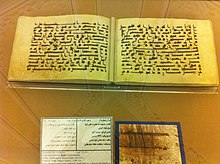
The Shia recite the Qur'an according to the
Other personal copies of the Quran might have existed including
Academic research
The Quran assumes the reader's
Since Muslims could regard

In 1972, in a mosque in the city of
In 2015, a single folio of a very early Quran, dating back to 1370 years earlier, was discovered in the library of the University of Birmingham, England. According to the tests carried out by the Oxford University Radiocarbon Accelerator Unit, "with a probability of more than 95%, the parchment was from between 568 and 645". The manuscript is written in Hijazi script, an early form of written Arabic.[75] This possibly was one of the earliest extant exemplars of the Quran, but as the tests allow a range of possible dates, it cannot be said with certainty which of the existing versions is the oldest.[75] Saudi scholar Saud al-Sarhan has expressed doubt over the age of the fragments as they contain dots and chapter separators that are believed to have originated later.[76] The Birmingham manuscript holds significance amongst scholarship because of its early dating and potential overlap with the dominant tradition over the lifetime of Muhammad c. 570 to 632 CE[77] and used as evidence to support conventional wisdom and to refute the revisionists' views on the history of the writing of the Quran.[78]
Significance in Islam
| Part of a series on |
| Islam |
|---|
 |
Muslims believe the Quran to be God's literal words,

Quran says, "With the truth we (God) have sent it down and with the truth it has come down"
Revered by pious Muslims as "the holy of holies",[87] whose sound moves some to "tears and ecstasy",[88] it is the physical symbol of the faith, the text often used as a charm on occasions of birth, death, marriage. Traditionally, before starting to read the Quran, ablution is performed, one seeks refuge in Allah from the accursed satan, and the reading begins by mentioning the names of Allah, Rahman and Rahim together known as basmala. Consequently,
It must never rest beneath other books, but always on top of them, one must never drink or smoke when it is being read aloud, and it must be listened to in silence. It is a talisman against disease and disaster.[87][89]
The Quran was the word of God (Kalām Allāh) (again, a word used for Jesus in the Quran (An-Nisa: 171), and its nature and whether it was created became a matter of fierce debate among religious scholars;[90][91] and with the involvement of the political authority in the discussions, some Muslim religious scholars who stood against the political stance faced religious persecution during the caliph al-Ma'mun period and the following years.
Muslims believe that the present Quranic text corresponds to that revealed to Muhammad, and according to their interpretation of Quran 15:9, it is protected from corruption ("Indeed, it is We who sent down the Quran and indeed, We will be its guardians").[92] Muslims consider the Quran to be a sign of the prophethood of Muhammad and the truth of the religion. For this reason, in traditional Islamic societies, great importance was given to children memorizing the Quran, and those who memorized the entire Quran were honored with the title of hafiz. Even today, millions of Muslims frequently refer to the Quran to justify their actions and desires",[m] and see it as the source of scientific knowledge,[94] though some refer to it as weird or pseudoscience.[95]
Inimitability
In
The Quran is widely regarded as the finest work in

The first works about the ’i‘jāz of the Quran began to appear in the 9th century in the
In a different line; The miracle claim that the Quran was encrypted using the number 19 was put forward by Rashad Khalifa; The claim attracted criticism because it included claims against the integrity of the text, which is mostly accepted by Muslims,[112][n] and the Khalifa was killed by his own student in an assassination[113] possibly organized by a Sunni radical group.[114]
In worship
Surah Al-Fatiha, the first chapter of the Quran, is recited in full in every rakat of salah and on other occasions. This surah, which consists of seven verses, is the most often recited surah of the Quran:[16]
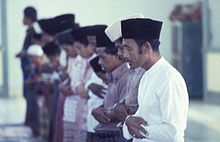
بِسْمِ ٱللَّهِ ٱلرَّحْمَٰنِ ٱلرَّحِيمِ |
In the Name of Allah the Entirely Merciful, the Especially Merciful. |
| —Quran 1:1-7 | —Sahih International English translation |
Other sections of the Quran of choice are also read in daily prayers. Surah
قُلۡ هُوَ ٱللَّهُ أَحَدٌ |
Say, ˹O Prophet,˺ “He is God—One ˹and Indivisible˺; |
| —Surah Al-Ikhlāṣ 112:1-4 | — The Clear Quran English translation
|
Respect for the written text of the Quran is an important element of religious faith by many Muslims, and the Quran is treated with reverence. Based on tradition and a literal interpretation of Quran 56:79 ("none shall touch but those who are clean"), some Muslims believe that they must perform a ritual cleansing with water (wudu or ghusl) before touching a copy of the Quran, although this view is not universal.[16] Worn-out copies of the Quran are wrapped in a cloth and stored indefinitely in a safe place, buried in a mosque or a Muslim cemetery, or burned and the ashes buried or scattered over water.[116] While praying, the Quran is only recited in Arabic.[117]
In Islam, most intellectual disciplines, including Islamic theology, philosophy, mysticism and jurisprudence, have been concerned with the Quran or have their foundation in its teachings.[16] Muslims believe that the preaching or reading of the Quran is rewarded with divine rewards variously called ajr, thawab, or hasanat.[118]
In Islamic art
The Quran also inspired Islamic arts and specifically the so-called Quranic arts of calligraphy and illumination.[16] The Quran is never decorated with figurative images, but many Qurans have been highly decorated with decorative patterns in the margins of the page, or between the lines or at the start of suras. Islamic verses appear in many other media, on buildings and on objects of all sizes, such as mosque lamps, metal work, pottery and single pages of calligraphy for muraqqas or albums.
-
Calligraphy, 18th century, Brooklyn Museum
-
Quranic inscriptions, Bara Gumbad mosque, Delhi, India
-
Quran page decoration art, Ottoman period
-
Quranic verses, Shahizinda mausoleum, Samarkand, Uzbekistan
-
The leaves from Quran written in gold and contoured with brown ink with a horizontal format suited to classical Kufic calligraphy, which became common under the early Abbasid caliphs.
Contents
The Quranic content is concerned with basic Islamic beliefs including the existence of

Many places, subjects and mythological figures in the
The stories of
Monotheism
The Quran uses cosmological and contingency arguments in various verses without referring to the terms to prove the existence of God. Therefore, the universe is originated and needs an originator, and whatever exists must have a sufficient cause for its existence. Besides, the design of the universe is frequently referred to as a point of contemplation: "It is He who has created seven heavens in harmony. You cannot see any fault in God's creation; then look again: Can you see any flaw?"[127][128]
The central theme of the Quran is monotheism. God is depicted as living, eternal, omniscient and omnipotent (see, e.g., Quran 2:20, 2:29, 2:255). God's omnipotence appears above all in his power to create. He is the creator of everything, of the heavens and the earth and what is between them (see, e.g., Quran 13:16, 2:253, 50:38, etc.). All human beings are equal in their utter dependence upon God, and their well-being depends upon their acknowledging that fact and living accordingly.[28][119]

Even though Muslims do not doubt about the existence and
Prophets
In Islam, God speaks to people called prophets through a kind of
Although wahy is similar to the
It is frequently repeated in the Quran that the universe, consisting of the
Mūsā is a prominent prophet and messenger of God and is the most frequently mentioned individual in the Quran, with his name being mentioned 136 times and his life being narrated and recounted more than that of any other prophet.[141][142]
Ethico-religious concepts

Belief is a fundamental aspect of morality in the Quran, and scholars have tried to determine the semantic contents of "belief" and "believer" in the Quran.
Eschatology
The doctrine of the last day and
The Quran is often vivid in its depiction of what will happen at the end time. Watt describes the Quranic view of End Time:[28]
The climax of history, when the present world comes to an end, is referred to in various ways. It is 'the Day of Judgment,' 'the Last Day,' 'the Day of Resurrection,' or simply 'the Hour.' Less frequently it is 'the Day of Distinction' (when the good are separated from the evil), 'the Day of the Gathering' (of men to the presence of God) or 'the Day of the Meeting' (of men with God). The Hour comes suddenly. It is heralded by a shout, by a thunderclap, or by the blast of a trumpet. A cosmic upheaval then takes place. The mountains dissolve into dust, the seas boil up, the sun is darkened, the stars fall and the sky is rolled up. God appears as Judge, but his presence is hinted at rather than described.… The central interest, of course, is in the gathering of all mankind before the Judge. Human beings of all ages, restored to life, join the throng. To the scoffing objection of the unbelievers that former generations had been dead a long time and were now dust and mouldering bones, the reply is that God is nevertheless able to restore them to life.
The Quran does not assert a natural immortality of the human soul, since man's existence is dependent on the will of God: when he wills, he causes man to die; and when he wills, he raises him to life again in a bodily resurrection.[130]
Science and the Quran
According to
Taner Edis wrote many Muslims appreciate technology and respect the role that science plays in its creation. As a result, he says there is a great deal of Islamic pseudoscience attempting to reconcile this respect with religious beliefs.[153] This is because, according to Edis, true criticism of the Quran is almost non-existent in the Muslim world. While Christianity is less prone to see its Holy Book as the direct word of God, fewer Muslims will compromise on this idea – causing them to believe that scientific truths must appear in the Quran.[153]
Starting in the 1970s and 80s, the idea of presence of scientific evidence in the Quran became popularized as
Enthusiasts of the movement argue that among the miracles found in the Quran are "everything, from
Critics argue, verses that proponents say explain modern scientific facts, about subjects such as
Text and arrangement

The Quran consists of 114 chapters of varying lengths, known as a
Each sūrah consists of verses, known as
In addition of the division into chapters, there are various ways of dividing Quran into parts of approximately equal length for convenience in reading. The 30
A different structure is provided by semantic units resembling paragraphs and comprising roughly ten āyāt each. Such a section is called a ruku.
The
According to one estimate the Quran consists of 77,430 words, 18,994 unique words, 12,183 stems, 3,382 lemmas and 1,685 roots.[172]
Literary style

The Quran's message is conveyed with various literary structures and devices. In the original Arabic, the suras and verses employ
The language of the Quran has been described as "rhymed prose" as it partakes of both poetry and prose; however, this description runs the risk of failing to convey the rhythmic quality of Quranic language, which is more poetic in some parts and more prose-like in others. Rhyme, while found throughout the Quran, is conspicuous in many of the earlier Meccan suras, in which relatively short verses throw the rhyming words into prominence. The effectiveness of such a form is evident for instance in Sura 81, and there can be no doubt that these passages impressed the conscience of the hearers. Frequently a change of rhyme from one set of verses to another signals a change in the subject of discussion. Later sections also preserve this form but the style is more expository.[174][175]
The Quranic text seems to have no beginning, middle, or end, its nonlinear structure being akin to a web or net.[16] The textual arrangement is sometimes considered to exhibit lack of continuity, absence of any chronological or thematic order and repetitiousness.[p][q] Michael Sells, citing the work of the critic Norman O. Brown, acknowledges Brown's observation that the seeming disorganization of Quranic literary expression—its scattered or fragmented mode of composition in Sells's phrase—is in fact a literary device capable of delivering profound effects as if the intensity of the prophetic message were shattering the vehicle of human language in which it was being communicated.[178][179] Sells also addresses the much-discussed repetitiveness of the Quran, seeing this, too, as a literary device.
A text is self-referential when it speaks about itself and makes reference to itself. According to Stefan Wild, the Quran demonstrates this metatextuality by explaining, classifying, interpreting and justifying the words to be transmitted. Self-referentiality is evident in those passages where the Quran refers to itself as revelation (tanzil), remembrance (dhikr), news (naba'), criterion (furqan) in a self-designating manner (explicitly asserting its Divinity, "And this is a blessed Remembrance that We have sent down; so are you now denying it?"),[180] or in the frequent appearance of the "Say" tags, when Muhammad is commanded to speak (e.g., "Say: 'God's guidance is the true guidance'", "Say: 'Would you then dispute with us concerning God?'"). According to Wild the Quran is highly self-referential. The feature is more evident in early Meccan suras.[181]
Interpretation
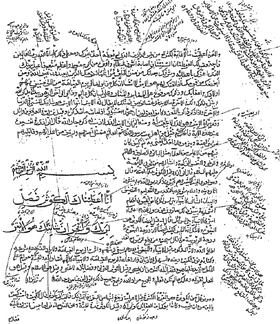
The Quran has sparked much commentary and explication (tafsir), aimed at explaining the "meanings of the Quranic verses, clarifying their import and finding out their significance."[182]
Tafsir is one of the earliest academic activities of Muslims. According to the Quran, Muhammad was the first person who described the meanings of verses for early Muslims.
Because the Quran is spoken in
There have been several commentaries of the Quran by scholars of all denominations, popular ones include
Esoteric interpretation
Esoteric or Sufi interpretation attempts to unveil the inner meanings of the Quran. Sufism moves beyond the apparent (zahir) point of the verses and instead relates Quranic verses to the inner or esoteric (batin) and metaphysical dimensions of consciousness and existence.[188] According to Sands, esoteric interpretations are more suggestive than declarative, they are allusions (isharat) rather than explanations (tafsir). They indicate possibilities as much as they demonstrate the insights of each writer.[189]
Sufi interpretation, according to Annabel Keeler, also exemplifies the use of the theme of love, as for instance can be seen in Qushayri's interpretation of the Quran:
When Moses came at the appointed time and his Lord spoke to him, he asked, "My Lord! Reveal Yourself to me so I may see You." Allah answered, "You cannot see Me! But look at the mountain. If it remains firm in its place, only then will you see Me." When his Lord appeared to the mountain, He levelled it to dust and Moses collapsed unconscious. When he recovered, he cried, "Glory be to You! I turn to You in repentance and I am the first of the believers."
— Quran 7:143
Moses, in 7:143, comes the way of those who are in love, he asks for a vision but his desire is denied, he is made to suffer by being commanded to look at other than the Beloved while the mountain is able to see God. The mountain crumbles and Moses faints at the sight of God's manifestation upon the mountain. In Qushayri's words, Moses came like thousands of men who traveled great distances, and there was nothing left to Moses of Moses. In that state of annihilation from himself, Moses was granted the unveiling of the realities. From the Sufi point of view, God is the always the beloved and the wayfarer's longing and suffering lead to realization of the truths.[190]
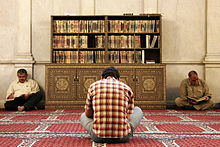
Muhammad Husayn Tabataba'i says that according to the popular explanation among the later exegetes, ta'wil indicates the particular meaning a verse is directed towards. The meaning of revelation (tanzil), as opposed to ta'wil, is clear in its accordance to the obvious meaning of the words as they were revealed. But this explanation has become so widespread that, at present, it has become the primary meaning of ta'wil, which originally meant 'to return' or 'the returning place'. In Tabatabaei's view, what has been rightly called ta'wil, or hermeneutic interpretation of the Quran, is not concerned simply with the denotation of words. Rather, it is concerned with certain truths and realities that transcend the comprehension of the common run of men; yet it is from these truths and realities that the principles of doctrine and the practical injunctions of the Quran issue forth. Interpretation is not the meaning of the verse—rather it transpires through that meaning, in a special sort of transpiration. There is a spiritual reality—which is the main objective of ordaining a law, or the basic aim in describing a divine attribute—and then there is an actual significance that a Quranic story refers to.[191][192]

According to Shia beliefs, those who are firmly rooted in knowledge like Muhammad and the imams know the secrets of the Quran. According to Tabatabaei, the statement "none knows its interpretation except God" remains valid, without any opposing or qualifying clause.[193] Therefore, so far as this verse is concerned, the knowledge of the Quran's interpretation is reserved for God. But Tabatabaei uses other verses and concludes that those who are purified by God know the interpretation of the Quran to a certain extent.[192]
According to
History of Sufi commentaries
One of the notable authors of esoteric interpretation prior to the 12th century is Sulami (d. 1021) without whose work the majority of very early Sufi commentaries would not have been preserved. Sulami's major commentary is a book named Haqaiq al-Tafsir ('Truths of Exegesis') which is a compilation of commentaries of earlier Sufis. From the 11th century onwards several other works appear, including commentaries by Qushayri (d. 1074), Daylami (d. 1193), Shirazi (d. 1209) and Suhrawardi (d. 1234). These works include material from Sulami's books plus the author's contributions. Many works are written in Persian such as the works of Maybudi (d. 1135) kashf al-asrar ('the unveiling of the secrets').[188] Rumi (d. 1273) wrote a vast amount of mystical poetry in his book Mathnawi. Rumi makes heavy use of the Quran in his poetry, a feature that is sometimes omitted in translations of Rumi's work. A large number of Quranic passages can be found in Mathnawi, which some consider a kind of Sufi interpretation of the Quran. Rumi's book is not exceptional for containing citations from and elaboration on the Quran, however, Rumi does mention Quran more frequently.[195] Simnani (d. 1336) wrote two influential works of esoteric exegesis on the Quran. He reconciled notions of God's manifestation through and in the physical world with the sentiments of Sunni Islam.[196] Comprehensive Sufi commentaries appear in the 18th century such as the work of Ismail Hakki Bursevi (d. 1725). His work ruh al-Bayan ('the Spirit of Elucidation') is a voluminous exegesis. Written in Arabic, it combines the author's own ideas with those of his predecessors (notably Ibn Arabi and Ghazali).[196]
Levels of meaning
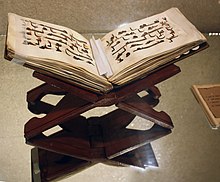
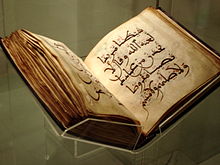
Unlike the Salafis, Shias and Sunnis as well as some other Muslim philosophers believe the meaning of the Quran is not restricted to the literal aspect.[197]: 7 For them, it is an essential idea that the Quran also has inward aspects. Henry Corbin narrates a hadith that goes back to Muhammad:
The Quran possesses an external appearance and a hidden depth, an exoteric meaning and an esoteric meaning. This esoteric meaning in turn conceals an esoteric meaning (this depth possesses a depth, after the image of the celestial Spheres, which are enclosed within each other). So it goes on for seven esoteric meanings (seven depths of hidden depth).[197]: 7
According to this view, it has also become evident that the inner meaning of the Quran does not eradicate or invalidate its outward meaning. Rather, it is like the soul, which gives life to the body.[198] Corbin considers the Quran to play a part in Islamic philosophy, because gnosiology itself goes hand in hand with prophetology.[197]: 13
Commentaries dealing with the
Reappropriation
Reappropriation is the name of the
Translations
Translating the Quran has always been problematic and difficult. Many argue that the Quranic text cannot be reproduced in another language or form.[202] Furthermore, an Arabic word may have a range of meanings depending on the context, making an accurate translation even more difficult.[203]
Nevertheless, the Quran has been translated into most African, Asian, and European languages.[60] The first translator of the Quran was Salman the Persian, who translated surat al-Fatiha into Persian during the seventh century.[204] Another translation of the Quran was completed in 884 in Alwar (Sindh, India, now Pakistan) by the orders of Abdullah bin Umar bin Abdul Aziz on the request of the Hindu Raja Mehruk.[205]
The first fully attested complete translations of the Quran were done between the 10th and 12th centuries in
Islamic tradition also holds that translations were made for Emperor Negus of Abyssinia and Byzantine Emperor
In 1936, translations in 102 languages were known.
Robert of Ketton's 1143 translation of the Quran for Peter the Venerable, Lex Mahumet pseudoprophete, was the first into a Western language (Latin).[208]
As with translations of the Bible, the English translators have sometimes favored archaic English words and constructions over their more modern or conventional equivalents; for example, two widely read translators, Abdullah Yusuf Ali and Marmaduke Pickthall, use the plural and singular ye and thou instead of the more common you.[209]
The oldest Gurmukhi translation of the Quran Sharif has been found in village Lande of Moga district of Punjab which was printed in 1911.[210]
-
1091 Quranic text in bold script with Persian translation and commentary in a lighter script[211]
-
Arabic Quran with interlinear Persian translation from the Ilkhanid Era
-
The first printed Quran in a European vernacular language: L'Alcoran de Mahomet, André du Ryer, 1647
-
Title page of the first German translation (1772) of the Quran
-
Verses 33 and 34 of suratYā Sīnin this Chinese translation of the Quran
Recitation
Rules of recitation
The proper recitation of the Quran is the subject of a separate discipline named tajwid which determines in detail how the Quran should be recited, how each individual syllable is to be pronounced, the need to pay attention to the places where there should be a pause, to elisions, where the pronunciation should be long or short, where letters should be sounded together and where they should be kept separate, etc. It may be said that this discipline studies the laws and methods of the proper recitation of the Quran and covers three main areas: the proper pronunciation of consonants and vowels (the articulation of the Quranic phonemes), the rules of pause in recitation and of resumption of recitation, and the musical and melodious features of recitation.[212]
In order to avoid incorrect pronunciation, reciters follow a program of training with a qualified teacher. The two most popular texts used as references for tajwid rules are Matn al-Jazariyyah by Ibn al-Jazari[213] and Tuhfat al-Atfal by Sulayman al-Jamzuri.
The recitations of a few Egyptian reciters, like
There are two types of recitation:
- Murattal is at a slower pace, used for study and practice.
- Mujawwad refers to a slow recitation that deploys heightened technical artistry and melodic modulation, as in public performances by trained experts. It is directed to and dependent upon an audience for the mujawwad reciter seeks to involve the listeners.[218]
Variant readings

Vocalization markers indicating specific vowel sounds (tashkeel) were introduced into the text of the Qur'an during the lifetimes of the last Sahabah.[219] The first Quranic manuscripts lacked these marks, enabling multiple possible recitations to be conveyed by the same written text. The 10th-century Muslim scholar from Baghdad, Ibn Mujāhid, is famous for establishing seven acceptable textual readings of the Quran. He studied various readings and their trustworthiness and chose seven 8th-century readers from the cities of Mecca, Medina, Kufa, Basra and Damascus. Ibn Mujahid did not explain why he chose seven readers, rather than six or ten, but this may be related to a prophetic tradition (Muhammad's saying) reporting that the Quran had been revealed in seven ahruf (meaning seven letters or modes). Today, the most popular readings are those transmitted by Ḥafṣ (d. 796) and Warsh (d. 812) which are according to two of Ibn Mujahid's reciters, Aasim ibn Abi al-Najud (Kufa, d. 745) and Nafi' al-Madani (Medina, d. 785), respectively. The influential standard Quran of Cairo uses an elaborate system of modified vowel-signs and a set of additional symbols for minute details and is based on ʻAsim's recitation, the 8th-century recitation of Kufa. This edition has become the standard for modern printings of the Quran.[45][68]
The variant readings of the Quran are one type of textual variant.[220][221] According to Melchert (2008), the majority of disagreements have to do with vowels to supply, most of them in turn not conceivably reflecting dialectal differences and about one in eight disagreements has to do with whether to place dots above or below the line.[222]
Nasser categorizes variant readings into various subtypes, including internal vowels, long vowels,
Occasionally, an early Quran shows compatibility with a particular reading. A Syrian manuscript from the 8th century is shown to have been written according to the reading of Ibn Amir ad-Dimashqi.[224] Another study suggests that this manuscript bears the vocalization of himsi region.[225]
Writing and printing
Writing
Before printing was widely adopted in the 19th century, the Quran was transmitted in manuscripts made by
In the beginning, the Quran was not written with dots or tashkeel. These features were added to the text during the lifetimes of the last of the Sahabah.[219] Since it would have been too costly for most Muslims to purchase a manuscript, copies of the Quran were held in mosques in order to make them accessible to people. These copies frequently took the form of a series of 30 parts or juzʼ. In terms of productivity, the Ottoman copyists provide the best example. This was in response to widespread demand, unpopularity of printing methods and for aesthetic reasons.[228][229]
Whilst the majority of Islamic scribes were men, some women also worked as scholars and copyists; one such woman who made a copy of this text was the Moroccan jurist, Amina, bint al-Hajj ʿAbd al-Latif.[230]
-
Folio from the "Blue" Quran at the Brooklyn Museum
-
Kufic script, eighth or ninth century
-
Maghribi script, 13th–14th centuries
-
Muhaqqaq script, 14th–15th centuries
-
Shikasta nastaliq script, 18th–19th centuries
Printing
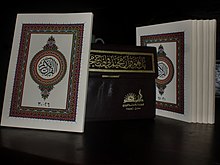
Wood-block printing of extracts from the Quran is on record as early as the 10th century.[231]
Arabic
Printed copies of the Quran during this period met with strong opposition from
In 1786, Catherine the Great of Russia, sponsored a printing press for "Tatar and Turkish orthography" in Saint Petersburg, with one Mullah Osman Ismail responsible for producing the Arabic types. A Quran was printed with this press in 1787, reprinted in 1790 and 1793 in Saint Petersburg, and in 1803 in Kazan.[s] The first edition printed in Iran appeared in Tehran (1828), a translation in Turkish was printed in Cairo in 1842, and the first officially sanctioned Ottoman edition was finally printed in Constantinople between 1875 and 1877 as a two-volume set, during the First Constitutional Era.[242][243]
Criticism
Regarding the claim of divine origin, critics refer to preexisting sources, not only taken from the Bible, supposed to be older revelations of God, but also from
Relationship with other literature

Some non-Muslim groups such as the Baháʼí Faith and Druze view the Quran as holy. In the Baháʼí Faith, the Quran is accepted as authentic revelation from God along with the revelations of the other world religions, Islam being a stage within the divine process of progressive revelation. Bahá'u'lláh, the Prophet-Founder of the Baháʼí Faith, testified to the validity of the Quran, writing, say: "Perused ye not the Qur'án? Read it, that haply ye may find the Truth, for this Book is verily the Straight Path. This is the Way of God unto all who are in the heavens and all who are on the earth."[247] Unitarian Universalists may also seek inspiration from the Quran. It has been suggested that the Quran has some narrative similarities to the Diatessaron, Protoevangelium of James, Infancy Gospel of Thomas, Gospel of Pseudo-Matthew and the Arabic Infancy Gospel.[248][249] One scholar has suggested that the Diatessaron, as a gospel harmony, may have led to the conception that the Christian Gospel is one text.[250]
The Bible
He has revealed to you ˹O Prophet˺ the Book in truth, confirming what came before it, as He revealed the Torah and the Gospel previously, as a guide for people, and ˹also˺ revealed the Standard ˹to distinguish between right and wrong˺.[251]
— 3:3-4
The Quran attributes its relationship with former books (the Torah and the Gospels) to their unique origin, saying all of them have been revealed by the one God.[252]
According to
Arab writing
After the Quran, and the general rise of Islam, the Arabic alphabet developed rapidly into an art form.[60] The Arabic grammarian Sibawayh wrote one of the earliest books on Arabic grammar, referred to as "Al-Kitab", which relied heavily on the language in the Quran. Wadad Kadi, Professor of Near Eastern Languages and Civilizations at University of Chicago, and Mustansir Mir, Professor of Islamic studies at Youngstown State University, state that the Quran exerted a particular influence on Arabic literature's diction, themes, metaphors, motifs and symbols and added new expressions and new meanings to old, pre-Islamic words that would become ubiquitous.[255]
See also
- Criticism of the Quran
- Historical reliability of the Quran
- List of chapters in the Quran
- List of translations of the Quran
- Quran and miracles
- Violence in the Quran
- Women in the Quran
- Quran code
- Digital Quran
- Hadith al-Thaqalayn
- Islamic schools and branches
- Quran translations
- Schools of Islamic theology
- The True Furqan
References
Notes
- ^ The English pronunciation varies: /kəˈrɑːn/, /-ˈræn/, /kɔː-/, /koʊ-/;[1] especially with the spelling quran /kʊrˈɑːn/, /-ˈræn/;[2] especially in British English /kɒrˈɑːn/.[3][4]
- ]. For example, the pronunciation in Egypt is [qorˈʔɑːn] and in Central East Arabia [qʊrˈʔæːn].
- lit. 'the recitation' or 'the lecture'
- ^ (English spelling) The form Alcoran (and its variants) was usual before the 19th century when it became obsolete.[5][6] The form Koran was most predominant from the second half of the 18th century till the 1980s, when it has been superseded by either Qur'an or Quran.[6][7][8][9] Other transliterations include al-Coran, Coran, Kuran and al-Qur'an. The adjectives vary as well and include Koranic, Quranic and Qur'anic (sometimes in lowercase).[10]
- ^ According to Welch in the Encyclopedia of Islam, the verses pertaining to the usage of the word hikma should probably be interpreted in the light of IV, 105, where it is said that "Muhammad is to judge (tahkum) mankind on the basis of the Book sent down to him."
- ^ Hadith are primarily from Muhammad but some are from those closest to him. Muslim scholars have worked carefully to authenticate them; see Hadith studies#Evaluating authenticity.
- ^ "God's Apostle replied, 'Sometimes it is (revealed) like the ringing of a bell, this form of Inspiration is the hardest of all and then this state passes off after I have grasped what is inspired. Sometimes the Angel comes in the form of a man and talks to me and I grasp whatever he says.' ʻAisha added: Verily I saw the Prophet being inspired Divinely on a very cold day and noticed the Sweat dropping from his forehead (as the Inspiration was over)."[31]
- ^ "Few have failed to be convinced that … the Quran is … the words of Muhammad, perhaps even dictated by him after their recitation."[48]
- ^ There is some disagreement among early Muslim sources disagree over who was the first to collect the narrations. At least one source credits Salim, the freed slave of Abu Hudhaifah with collecting the Qur'an into a mushaf:
"It is reported... from Ibn Buraidah who said:
The first of those to collect the Qur'an into a mushaf (codex) was Salim, the freed slave of Abu Hudhaifah.[49]
- ^ For example:
- "We have, without doubt, sent down the Message; and We will assuredly guard it (from corruption)" (15:9)
- Among the things that make the Quran "a miracle and that supplements the idea or belief that Islam is the true religion. This unique feature of Quran is its protected nature where there has not been even a single change in the syllable in which it was revealed. The lines below discuss how the protected nature of Quran stands as an evidence for Islam being the true divine belief.
- "The Quran is unique because it is the only revealed book that exists today in the precise form and content in which it was originally revealed.[52]
- ^ In a small number of denominations, only the Quran is used as a source, an approach called Quranism.
- ^ For both the claim that variant readings are still transmitted and the claim that no such critical edition has been produced, see Gilliot, C., "Creation of a fixed text" [70]
- ^ professor emeritus of Islamic thought at the University of Paris, Algerian Mohammed Arkoun.[93]
- ^ "Few have failed to be convinced that … the Quran is … the words of Muhammad, perhaps even dictated by him after their recitation."[48]
- ^ Scholars disagree on the exact number but this is a disagreement over "the placing of the divisions between the verese, not on the text itself."[166]
- ^ "The final process of collection and codification of the Quran text was guided by one over-arching principle: God's words must not in any way be distorted or sullied by human intervention. For this reason, no serious attempt, apparently, was made to edit the numerous revelations, organize them into thematic units, or present them in chronological order... This has given rise in the past to a great deal of criticism by European and American scholars of Islam, who find the Quran disorganized, repetitive and very difficult to read."[176]
- ^ Samuel Pepys: "One feels it difficult to see how any mortal ever could consider this Quran as a Book written in Heaven, too good for the Earth; as a well-written book, or indeed as a book at all; and not a bewildered rhapsody; written, so far as writing goes, as badly as almost any book ever was!" [177]
- ^ "the major Ottoman printing houses published a combined total of only 142 books in more than a century of printing between 1727 and 1838. When taken in conjunction with the fact that only a minuscule number of copies of each book were printed, this statistic demonstrates that the introduction of the printing press did not transform Ottoman cultural life until the emergence of vibrant print media in the middle of the nineteenth century" [240]
- ^ "at imperial expense, a 'Tatar and Turkish Typography' was established in St. Petersburg; a domestic scholar, Mullah Osman Ismail, was responsible for the manufacture of the types. One of the first products of this printing house was the Qur'ān. Through the doctor and writer, Johann Georg v. Zimmermann (d. 1795), who was befriended by Catherine II, a copy of the publication arrived in the Göttingen University library. Its director, the philologist Christian Gottlob Heyne (d. 1812), presented the work immediately in the Göttingische Anzeigen von gelehrten Sachen (28 July 1788); therein he pointed especially to the beauty of the Arabic types. To the Arabic text marginal glosses have been added that consist predominantly of reading variants. The imprint was reproduced unchanged in 1790 and 1793 in St. Petersburg (cf. Schnurrer, Bibliotheca arabica, no. 384); later, after the transfer of the printing house to Kazan, editions appeared in different formats and with varying presentation [241]
- ^ non-Muslim scientists have also found the case for Quranic prescient explanation about embryology lacking. Pharyngula. "Islamic embryology: overblown balderdash". science blogs. Retrieved 10 August 2020.
Citations
- ^ dictionary.reference.com: koran
- ^ dictionary.reference.com: quran
- ^ Cambridge dictionary: koran
- ^ Cambridge dictionary: quran
- ^ "Alcoran". Oxford English Dictionary. Vol. 1 (1st ed.). Oxford University Press. 1888. p. 210.
- ^ a b "Google Books Ngram Viewer". Google Books. Retrieved 16 February 2021.
- ^ "Koran". Oxford English Dictionary. Vol. 5 (1st ed.). Oxford University Press. 1901. p. 753.
- ^ "Koran". Oxford English Dictionary (Online ed.). Oxford University Press. (Subscription or participating institution membership required.)
- ^ "Quran". Oxford English Dictionary (Online ed.). Oxford University Press. (Subscription or participating institution membership required.)
- ^ "Koran". Merriam-Webster.com Dictionary.
- ^ Guillaume, Alfred (1954). Islam. Edinburgh: Penguin books. p. 74.
It may be affirmed that within the literature of the Arabs, wide and fecund as it is both in poetry and in elevated prose, there is nothing to compare with it.
- ISBN 978-1-59257-222-9.
Muslims believe that Muhammad's many divine encounters during his years in Mecca and Medina inspired the remainder of the Qur'an, which, nearly fourteen centuries later, remains the Arabic language's preeminent masterpiece.
- ISBN 978-0-19-539600-3.
Throughout history, many Arab Christians as well have regarded it as the perfection of the Arabic language and literature.
- ISBN 978-0-8264-4957-3.
- ^ "The Comprehensive Aramaic Lexicon". Hebrew Union College – Jewish Institute of Religion. Archived from the original on 18 October 2017. Retrieved 31 August 2013.
- ^ a b c d e f g h i j k l m n Nasr 2007
- ^ Quran 75:17
- ^ Quran 7:204
- ^ See "Ķur'an, al-", Encyclopedia of Islam Online and 9:111
- ^ Quran 20:2 cf.
- ^ Quran 25:32 cf.
- ISBN 978-1-904063-30-8.
- ^ Surah Al-Qadr 97
- ^ ISBN 978-1-84980-013-6.
- ^ I. B. Tauris Publishers. p. 338.
- ^ Quran 17:106
- ^ Tabatabae 1988, p. 98
- ^ ISBN 978-0-85224-171-4.
- ^ ISBN 978-0-521-29135-4.
- ISBN 978-0-86037-132-8.
- ^ "Translation of Sahih Bukhari, Book 1". Center for Muslim-Jewish Engagement. University of Southern California. Archived from the original on 10 January 2012.
- ^ Quran 53:5
- ^ Quran 53:6-9
- ISBN 978-90-04-08265-6.
- ^ Quran 7:157
- .
- ^ ISBN 978-0-8160-5454-1.
- ^ a b Donner, Fred (2006). "The historical context". In McAuliffe, Jane Dammen (ed.). The Cambridge Companion to the Qur'ān. Cambridge University Press. pp. 31–33.
- ISSN 2232-0474.
- ^ "Wat is de Koran?". Koran.nl (in Dutch). 18 February 2016.
- ^ Cook 2000, p. 121.
- ^ a b c Tabatabae 1988, p. 99:
Since the word of God seemed threatened with alteration, the [third] caliph ordered that five of the qurrā' from amongst the companions, (one of them being Zayd ibn Thābit who had compiled the first volume), produce other copies from the first volume which had been prepared on the orders of the first caliph and which had been kept with Ḥafṣah, the wife of the Prophet and daughter of the second caliph.
The other copies, already in the hands of Muslims in other areas, were collected and sent to Medina where, on orders of the Caliph, they were burnt (or, according to some historians, were destroyed by boiling). Thus several copies were made, one being kept in Medina, one in Mecca, and one each sent to Sham (a territory now divided into Syria, Lebanon, Palestine and Jordan), Kufa and Basra.
It is said that beside these five, one copy was also sent to Yemen and one to Bahrein. These copies were called the Imam copies and served as original for all future copies. The only difference of order between these copies and the first volume was that the chapters "Spirits of War" and "Immunity" were written in one place between "The Heights" and "Jonah."
- ^ al-Bukhari, Muhammad. "Sahih Bukhari, volume 6, book 61, narrations number 509 and 510". sahih-bukhari.com. Retrieved 16 February 2018.
- ^ Cook 2000, p. 117.
- ^ a b c Rippin 2006:
- "Poetry and Language", by Navid Kermani, pp. 107–20.
- For the history of compilation see "Introduction," by Tamara Sonn, pp. 5–6
- For eschatology, see "Discovering (final destination)", by Christopher Buck, p. 30.
- For literary structure, see "Language," by Mustansir Mir, p. 93.
- For writing and printing, see "Written Transmission", by François Déroche, pp. 172–87.
- For recitation, see "Recitation," by Anna M. Gade pp. 481–93
- ^ Yusuff, Mohamad K. "Zayd ibn Thabit and the Glorious Qur'an".
- ^ Cook 2000, pp. 117–124.
- ^ a b Peters 1991, pp. 3–5
- ^ John Gilchrist, Jam' Al-Qur'an. The Codification of the Qur'an Text A Comprehensive Study of the Original Collection of the Qur'an Text and the Early Surviving Qur'an Manuscripts, [MERCSA, Mondeor, 2110 Republic of South Africa, 1989], Chapter 1. "The Initial Collection of the Qur'an Text", citing as-Suyuti, Al-Itqan fii Ulum al-Qur'an, p. 135).
- ^ Mazhar Kazi (1997). 130 Evident Miracles in the Qur'an. Richmond Hill: Crescent Publishing House. pp. 42–43.
- ^ "Islam Is True Divine Belief Because Of Protected Quran". quran reading. 17 August 2014.
- ^ "The Origin of the Quran" (PDF). October 2017. Retrieved 9 November 2013.
- ^ "Noorullah Website - Is the Qur'an Corrupted? Shi'ites View". 27 October 2009. Archived from the original on 27 October 2009.
- ^ Shirazi, Muhammad (2001). The Qur'an - When was it compiled?. London,UK: Fountain Books. pp. 5, 7.
- ^ Shirazi, Muhammad (2008). The Shi'a and their Beliefs. London,UK: Fountain Books. p. 29.
- ^ HADDADIAN ABDORREZA; MOADDAB SEYYED REZA. "A STUDY ON TRADITIONS OF DISTORTION IN AYYASHI EXEGESIS". Hadith Studies. 4 (8): 141–166.
- ISSN 1567-2808.
- ^ Kohlberg & Amir-Moezzi 2009, p.24-26-27
- ^ Kohlberg & Amir-Moezzi 2009, pp.20, 24
- ^ ISBN 978-0-415-32639-1.
- For God in the Quran (Allah), see "Allah", by Zeki Saritoprak, pp. 33–40.
- For eschatology, see "Eschatology," by Zeki Saritoprak, pp. 194–99.
- For searching the Arabic text on the internet and writing, see "Cyberspace and the Qur'an", by Andrew Rippin, pp. 159–63.
- For calligraphy, see by "Calligraphy and the Qur'an" by Oliver Leaman, pp. 130–35.
- For translation, see "Translation and the Qur'an," by Afnan Fatani, pp. 657–69.
- For recitation, see "Art and the Qur'an" by Tamara Sonn, pp. 71–81; and "Reading", by Stefan Wild, pp. 532–35.
- ISBN 978-0-253-21627-4.
- ISBN 978-0-8264-4956-6.
- ^ Nasr 2003, p. 42
- higher criticismof the Quran."
- ^ Egypt's culture wars: politics and practice – Page 278 Samia Mehrez – 2008 Middle East report: Issues 218–222; Issues 224–225 Middle East Research & Information Project, JSTOR (Organization) – 2001 Shahine filed to divorce Abu Zayd from his wife, on the grounds that Abu Zayd's textual criticism of the Quran made him an apostate, and hence unfit to marry a Muslim. Abu Zayd and his wife eventually relocated to the Netherlands
- ^ Donner, "Quran in Recent Scholarship", 2008: p.30
- doi:10.1086/674909.
- ^ JSTOR 1596266.
- ISBN 1-59102-430-7
- ^ Gilliot, C. (2006). "Creation of a fixed text". In McAuliffe, Jane Dammen (ed.). The Cambridge Companion to the Qur'ān. Cambridge University Press. p. 52.
- .
- .
- S2CID 164120434.
- ^ Lester, Toby (January 1999). "What Is the Koran?". Atlantic. Retrieved 24 September 2019.
- ^ a b Coughlan, Sean. "'Oldest' Koran fragments found in Birmingham University". BBC. Retrieved 22 July 2015.
- ^ Dan Bilefsky (22 July 2015). "A Find in Britain: Quran Fragments Perhaps as Old as Islam". New York Times. Retrieved 28 July 2015.
- ^ Elizabeth Goldman (1995), p. 63, gives 8 June 632, the dominant Islamic tradition. Many earlier (mainly non-Islamic) traditions refer to him as still alive at the time of the invasion of Palestine. See Stephen J. Shoemaker, The Death of a Prophet: The End of Muhammad's Life and the Beginnings of Islam,[page needed] University of Pennsylvania Press, 2011.
- ^ "New Light on the History of the Quranic Text?". The Huffington Post. 24 July 2015. Retrieved 27 July 2015.
- ^ Carroll, Jill. "The Quran & Hadith". World Religions. Retrieved 10 July 2019.
- ISBN 978-0-340-58795-9
- ISBN 978-1-4497-6013-7.
- ]
- ^ See:
- Corbin 1993, p. 12
- Wild, Stefan (1996). The Quʼran as Text. Leiden: Brill. pp. 137, 138, 141, 147. ISBN 978-90-04-09300-3.
- Quran 2:97, 17:105
- ^ Jenssen, H. (2001). "Arabic Language". In McAuliffe, Jane Dammen (ed.). Encyclopedia of the Qurʾān. Vol. 1. Leiden: Brill. pp. 127–35.
- ^ ISBN 978-1-4051-8093-1.
- ^ Quran 85:22
- ^ a b Guillaume, Islam, 1954: p.74
- ^ Pickthall, M.M. (1981). The Glorious Qur'an. Chicago IL: Iqra' Book Center. p. vii.
- ^ Ibn Warraq, Why I'm Not a Muslim, 1995: p.105
- ^ Patton, Ibn Ḥanbal and the Miḥna, 1897: p.54
- ISBN 978-0-19-530503-6. Retrieved 28 February 2019.
- ISBN 978-81-7835-805-5.
- ^ LESTER, TOBY (January 1999). "What Is the Koran?". Atlantic. Retrieved 8 April 2019.
- ISSN 0591-2385. Retrieved 15 April 2019.
- ^ SARDAR, ZIAUDDIN (21 August 2008). "Weird science". New Statesman. Retrieved 15 April 2019.
- ^ Leaman, Oliver, ed. (2006). The Qur'an: an encyclopedia. Routledge. ISBN 9780415326391
- ISBN 978-0-691-11461-3.
- ^ For example see comments by Arthur John Arberry: "to produce something which might be accepted as echoing however faintly the sublime rhetoric of the Arabic Koran, I have been at pains to study the intricate and richly varied rhythms which constitute the Koran's undeniable claim to rank amongst the greatest literary masterpieces of mankind Arberry, A.J (1955). The Koran: Interpreted. New York: Macmillan. pp. x; Karen Armstrong : "It is as though Muhammad had created an entirely new literary form that some people were not ready for but which thrilled others. Without this experience of the Koran, it is extremely unlikely that Islam would have taken root." Armstrong, K (1994). A History of God.p.78; Oliver Leaman: "the verses of the Qur'an represent its uniqueness and beauty not to mention its novelty and originality. That is why it has succeeded in convincing so many people of its truth. it imitates nothing and no one nor can it be imitated. Its style does not pall even after long periods of study and the text does not lose its freshness over time" Leaman, Oliver (2006). The Qur'an: an Encyclopedia.p.404 and similar views by Joseph Schacht (1974) The legacy of Islam, Henry Stubbe An account of the Rise and Progress of Mohammadanism (1911), Martin Zammit A Comparative Lexical Study of Qur'anic Arabic (2002), and Alfred Guillaume Islam (1990)
- ^ .
- ISBN 0-684-82507-4.]
It may be affirmed that within the literature of the Arabs, wide and fecund as it is both in poetry and in elevated prose, there is nothing to compare with it.
{{cite book}}: CS1 maint: location missing publisher (link)[clarification needed - ISBN 978-1-59257-222-9.
Muslims believe that Muhammad's many divine encounters during his years in Mecca and Medina inspired the remainder of the Qur'an, which, nearly fourteen centuries later, remains the Arabic language's preeminent masterpiece.
- ^ ISBN 978-0-19-539600-3.
Throughout history, many Arab Christians as well have regarded it as the perfection of the Arabic language and literature.
- ^ https://bircu-journal.com/index.php/birci/article/download/5578/pdf
- ^ a b https://www.pure.ed.ac.uk/ws/portalfiles/portal/75126557/Siddiqui2018PoetryProphecyAndTheAngelicVoice.pdf
- ^ https://www.um.edu.mt/library/oar/bitstream/123456789/51535/1/Humanitas2A7.pdf
- ^ https://dergipark.org.tr/tr/download/article-file/341691
- ^ Vgl. Martin 533
- ^ Vgl. Neuwirth 177 und Grotzfeld 65.
- ^ Larkin, Margaret (1988). "The Inimitability of the Qur'an: Two Perspectives". Religion & Literature. 20 (1): 31–47.
- ^ Quran 17:88
- ^ Vgl. Neuwirth 172-175.
- ^ Warraq I, et al. Warraq I (ed.). "The Origins of the Koran: Classic Essays on Islam's Holy Book". The Christian response to the Muslim debate. Summarised by Sharon Morad, Leeds. Archived from the original on 18 May 2011. Retrieved 15 March 2011.
- ^ Massinon, Stephane (30 April 2009). "Calgary police nab suspect in imam killing". National Post. The National Post Company. Retrieved 23 May 2009. [dead link]
- Denver Post, 21 October 1993, p21.
- ^ Seyyed Hossein Nasr (2015), The Study Quran, HarperCollins, p. 1578.
- ^ "Afghan Quran-burning protests: What's the right way to dispose of a Quran?". Slate Magazine. 22 February 2012.
- Street, Brian V.(2001). Literacy and Development: Ethnographic Perspectives. p. 193.
- ^ Sengers, Erik (2005). Dutch and Their Gods. p. 129.
- ^ ISBN 978-0-415-42124-9.
- ^ Crone, Patricia (10 June 2008). "What do we actually know about Mohammed?". Open Democracy. Retrieved 3 October 2019.
- ISBN 978-9004100633.
- ^ After examining the verses of the Quran to find where the word mythology has been used and seeking the accordance between the meaning and context with Quran’s purpose of knowledge and guidance, including rules and educational issues, we found that the concept of myth is not acceptable in the Quran. The result of this study show that Quran is not a myth, rather the stories are factual and based on reality. https://www.iasj.net/iasj/download/194df3cf9e25bbef
- ^ Watt 1960–2007: "It is generally agreed both by Muslim commentators and modéra [sic] occidental scholars that Dhu ’l-Ḳarnayn [...] is to be identified with Alexander the Great." Cook 2013: "[...] Dhū al-Qarnayn (usually identified with Alexander the Great) [...]".
- ISBN 978-90-04-27764-9.
Many Mediaeval scholars argued against the identification, though. Cf., e.g., the discussion in al-Maqrizi, Khabar §§212-232.
- ISBN 978-90-04-35599-6.
- ISBN 978-1-78673-131-9.
In the early history of Islam there was a lively debate over the true identity of Dhū 'l-Qarnayn. One prominent identification was with an ancient South Arabian Ḥimyarī king, generally referred to in the sources as al-Ṣaʿb b. Dhī Marāthid. [...] Indeed the association of Dhū 'l-Qarnayn with the South Arabian ruler can be traced in many early Arabic sources.
- ^ Quran 67:3
- ISBN 978-0-415-32639-1.
- ^ Quran 41:43
- ^ ISBN 978-0-02-865603-8.
- ^ Mutahhari, Murtada; Qara'i, 'Ali Quli (translator). "An Introduction to 'Ilm al-Kalam". muslimphilosophy. Retrieved 29 March 2018.
{{cite web}}:|first2=has generic name (help) - ISBN 978-90-04-16121-4.
- ^ Andreasen 1981.
- ^ Clay 1923, pp. 109, 132.
- ^ The Weidner "Chronicle" mentioning Kubaba from A. K. Grayson, Assyrian and Babylonian Chronicles (1975)
- ^ Munn, Mark (2004). "Kybele as Kubaba in a Lydo-Phrygian Context": Emory University cross-cultural conference "Hittites, Greeks and Their Neighbors in Central Anatolia" (Abstracts)
- ^ Lerner, Gerda (1986). History of Women vol. 1 : The Creation of Patriarchy. Oxford University Press. pp. 184–185.
- ^ Schnurer, Eric (3 August 2017). "The Age-Old Urban-Rural Conflict". U.S. News & World Report.
- ^ "Cain & Abel". World History Encyclopedia.
- ^ "Cain and Abel's clash may reflect ancient Bronze Age rivalries". Culture. 10 April 2019. Archived from the original on 14 March 2021.
- ^ Ltd, Hymns Ancient Modern (May 1996). Third Way (magazine). p. 18. Archived from the original on 17 June 2016. Retrieved 7 January 2016.
- ^ ISBN 978-0-567-08171-1. Archived from the originalon 29 April 2016.
- ISBN 978-0-7735-2427-9.
- ^ Quran 2:274
- ^ Quran 9:103
- ISBN 978-1-4051-1752-4.
- ISBN 978-1-86064-650-8.
- ISBN 978-0-415-32639-1.
- ^ Ali, Shamsher. "Science and the Qur'an" (PDF). In Oliver Leaman (ed.). The Qurʼan: An Encyclopedia. p. 572. Retrieved 13 May 2018.
- ISSN 0591-2385. Retrieved 15 April 2019.
- ISBN 978-1848855175.
- ^ Stark, Rodney, The Victory of Reason, Random House: 2005, pp. 20–21.
- ^ a b "Reasonable Doubts Podcast". CastRoller. 11 July 2014. Archived from the original on 23 May 2013. Retrieved 23 July 2014.
- ^ a b c d SARDAR, ZIAUDDIN (21 August 2008). "Weird science". New Statesman. Retrieved 11 April 2019.
- ^ a b c Cook 2000, p. 30
- ^ Cook 2000, p. 29
- JSTOR 25728019.
- ^ Moore, Keith L. (1983). The Developing Human: Clinically Oriented Emryology with Islamic Additions. Abul Qasim Publishing House (Saudi Arabia). Archived from the original on 29 January 2020. Retrieved 8 August 2020.
- ^ Rizvi, Atheist Muslim, 2016: p.120-1
- ^ Joseph Needham, revised with the assistance of Arthur Hughes, A History of Embryology (Cambridge, Cambridge University Press, 1959), p.82
- ^ see also: Ruthven, Malise. 2002. A Fury For God. London: Granta. p. 126.
- ^ "Beyond Bucailleism: Science, Scriptures and Faith". Evidence for God's Unchanging World. 21 July 2014. Retrieved 9 August 2020.
- ISBN 978-90-04-42271-1.
- ^ See:* "Kur`an, al-", Encyclopaedia of Islam Online
- ^ Allen 2000, p. 53.
- ^ Cook 2000, p. 119.
- ^ مقطعات is the plural of a participle from قطع, 'to cut, break'.
- ^ ISBN 90-04-12354-7.
- ISBN 0-520-07298-7.
- ^ "Appendix 1, One of the Great Miracles [74:35]". ICS/Masjid Tucson. Retrieved 8 June 2021.
- ^ Philips, Bilal. The Qur'an's Numerical Miracle: Hoax and Heresy (PDF). Archived from the original (PDF) on 1 March 2024.
- ^ Dukes, Kais. "RE: Number of Unique Words in the Quran". The Mail Archive. Retrieved 29 October 2012.
- ISBN 90-04-12354-7
- ISBN 978-1-4051-1752-4.
- ^ Rosenthal, Herman; Waldstein, A. S. "Körner, Moses B. Eliezer". Jewish Encyclopedia. Retrieved 15 August 2022.
- ^ Approaches to the Asian Classics, Irene Blomm, William Theodore De Bary, Columbia University Press, 1990, p. 65
- ^ Peterson, Daniel C. (1990). "Editor's Introduction: By What Measure Shall We Mete?". FARMS Review of Books. The Neal A. Maxwell Institute for Religious Scholarship at BYU. Archived from the original on 4 March 2008. Retrieved 30 September 2013.
- ^ Sells, Michael (1999), Approaching the Qur'ān, White Cloud Press
- JSTOR 466329.
- ^ Quran 21:50
- ISBN 978-3-447-05383-9.
- ^ a b "An Exegesis of the Holy Qur'an". Tafsir Al-Mizan. Tawheed Institute Australia.
- ^ Quran 2:151
- ^ بازمول, محمد. التهذيب والترتيب الاتقان في علوم القرآن. p. 525.
- ^ "How can there be abrogation in the Quran?". Archived from the original on 8 June 2008.
- ^ "Are the verses of the Qur'an Abrogated and/or Substituted?". mostmerciful.com. Archived from the original on 1 May 2008.
- ^ Islahi, Amin Ahsan. "Abrogation in the Qur'ān". Renaissance Journal. Retrieved 26 April 2013.
- ^ ISBN 978-1-4051-8820-3.
- ISBN 978-0-415-36685-4.
- .
- Tabataba'I, Allamah. "The Principles of Interpretation of the Qur'an". Tafseer Al-Mizan. Archived from the originalon 1 December 2008. Retrieved 16 February 2021.
- ^ Tabatabai, Allamah. "Al-Mizan Discourses". Tafsir Al-Mizan <!-– Allamah Muhammad Hussein Tabatabai -->. Archived from the originalon 8 December 2008. Retrieved 16 February 2021.
- ^ Quran 3:7
- ^ "The Qur'an Possesses Revelation and Exegesis". Allamah Tabatabaee. Islamic Ma'aref Foundation Institute. 1988. pp. 37–45. Archived from the original on 16 February 2012.
- ISBN 978-1-4051-8820-3.
- ^ .
- ^ a b c Corbin 1993
- Tabataba'I, Allamah. "The Outward and Inward Aspects of the Qur'an". Tafseer Al-Mizan <!-– Allamah Muhammad Hussein Tabatabai -->. Archived from the originalon 5 July 2008. Retrieved 16 February 2021.
- S2CID 143088125.
- ISBN 978-0-19-093288-6. Retrieved 29 December 2023.
- ^ Miller, Duane Alexander (June 2009). "Reappropriation: An Accommodationist Hermeneutic of Islamic Christianity". St Francis Magazine. 5 (3): 30–33. Retrieved 17 December 2014.
- ^ Aslan, Reza (20 November 2008). "How To Read the Quran". Slate. Retrieved 21 November 2008.
- ^ ISBN 978-0-415-32639-1
- ^ An-Nawawi, Al-Majmu', (Cairo: Matba'at at-Tadamun n.d.), 380.
- ^ "English Translations of the Quran". Monthly Crescent. July 2009. Archived from the original on 29 April 2014.
- ^ C.E. Bosworth. Encyclopedia of Islam 2nd ed, Brill. "Al-Tabari, Abu Djafar Muhammad b. Djarir b. Yazid", Vol. 10, p. 14.
- ^ "More than 300 publishers visit Quran exhibition in Iran". Hürriyet Daily News and Economic Review. 12 August 2010.
- ISBN 978-0-300-09422-0.
- ^ "Al-i-Imran (The Family of Imran) Part 1". Read Quran Online. Archived from the original on 18 November 2010. Retrieved 21 November 2010.
- The Tribune. Retrieved 26 August 2016.
- ^ Alya Karame. "Qur'ans from the Eastern Islamic World between the 4th/10th and 6th/12th Centuries" (PDF). The University of Edinburgh. p. 109.
- ^ ISBN 978-0-415-32639-1:, pp. 71–81;
- "Art and the Qur'an" by Tamara Sonn
- "Reading," by Stefan Wild, pp. 532–35.
- ^ Thānawi, Qāri Izhār (21 January 2019). "The Great Imām of Qirā'ah: Muhammad Ibn al-Jazari". IlmGate. Retrieved 9 September 2020.
- ^ Taha Shoeb (2 February 2018) [28 September 2017]. "Khalaf from Hamzah – A look at the features of recitation of al-Qur'an by Shahzada Husain Bhaisaheb". The Dawoodi Bohras. Archived from the original on 19 May 2020.
- ^ Ejaz Taj (6 September 2018). "A Meeting with the Egyptian Giants, al-Minshāwī, al-Huṣrī, Muṣṭafā Ismāʿīl and ʿAbdul-Bāsit ʿAbdus-Ṣamad". islam21c.com. Archived from the original on 18 May 2020. Retrieved 18 May 2020.
- ISBN 978-0-7546-3457-7. Archived from the originalon 19 May 2020 – via pdfslide.net.
- ^ "Best Quran Recitation Competition for Students Planned in Egypt". iqna.ir. 4 May 2020. Archived from the original on 19 May 2020.
- ISBN 978-977-424-594-7.
- ^ a b Ibn Taymiyyah, Ahmed. Majmue Alfatawaa مجموع الفتاوى [Total Fatwas]. p. 12/576.
- ^ Rippin 2006:
- "Written Transmission," by François Déroche, pp. 172–87.
- "Recitation," by Anna M. Gade, pp. 481–93
- ISBN 978-0-7391-4291-2.
- .
- ISBN 978-90-04-24081-0.
- .
- .
- ^ ISBN 978-1-4051-1752-4.
- ISBN 978-90-04-10692-5.
- ISBN 978-1-85043-760-4.
- ^ ISBN 90-04-09239-0.
- ISBN 978-0-19-538207-5. Retrieved 1 July 2022.
- ^ "Muslim Printing Before Gutenberg". muslimheritage.com.
- ^ Krek 1979, p. 203
- ^ "Saudi Aramco World: East Meets West in Venice". archive.aramcoworld.com. Archived from the original on 2 November 2013. Retrieved 16 February 2021.
- .
- ^ "Paganini Quran". Madain Project. Archived from the original on 6 May 2020. Retrieved 6 May 2020.
- ^ "The Quran in East and West: Manuscripts and Printed Books". Columbia University Libraries Online Exhibitions. Retrieved 3 April 2017.
- ^ "Alcorani textus universus ex correctioribus Arabum exemplaribus summa fide, atque pulcherrimis characteribus descriptus, vol. 2, p. i". Columbia University Libraries Online Exhibitions. Retrieved 3 April 2017.
- ISBN 978-1-85043-760-4.
- ^ Watson 1968, p. 435; Clogg 1979, p. 67
- ^ Hanioğlu, Şükrü (2010). A Brief History of the Late Ottoman Empire. Princeton University Press.
- ISBN 90-04-12354-7.
- ISBN 978-1-349-74030-7.
- ISBN 978-0-230-58347-4.
- ^ Quran 25:5
- ^ "China removed popular Quran apps, with one million Chinese users; BBC". Business Insider.
- ^ "China to rewrite Quran, Bible amid crackdown on Uighur minority". ahvalnews.com. 25 December 2019.
- ^ "The Kitáb-i-Íqán". Bahá'í Reference Library. Retrieved 6 August 2021.
- ISBN 978-0-203-93960-4.
- New Catholic Encyclopedia. Vol. 7. Washington, DC: Catholic University of America. 1967. p. 677.
- ISBN 978-1-57392-945-5.
- ^ 3:3 نزل عليك الكتاب بالحق مصدقا لما بين يديه وانزل التوراة والانجيل
- ^ Quran 2:285
- ISBN 978-3-89930-088-8.
- ISBN 978-0-19-516521-0.
Christians are often surprised to discover that Jesus is mentioned by name in the Quran more than Muhammad and that Mary is mentioned more times in the Quran than in the New Testament. Both Jesus and Mary play important roles not only in the Quran but also in Muslim piety and spirituality.
- ISBN 90-04-12354-7.
Sources
- Allen, Roger (2000). An Introduction to Arabic literature. Cambridge University Press. ISBN 978-0-521-77657-8.
- Clogg, Richard (1979). "An Attempt to Revive Turkish Printing in Istanbul in 1779". International Journal of Middle East Studies. 10 (1): 67–70. S2CID 159835641.
- .
- ISBN 978-0-19-285344-8. Retrieved 24 September 2019.
- ISBN 978-0-7103-0416-2.
- Guessoum, Nidhal (2011). Islam's Quantum Question: Reconciling Muslim Tradition and Modern Science. I.B. Tauris. p. 174. ISBN 978-1-84885-517-5.
- Krek, Miroslav (1979). "The Enigma of the First Arabic Book Printed from Movable Type". Journal of Near Eastern Studies. 38 (3): 203–212. S2CID 162374182.
- ISBN 978-0-06-050714-5.
- Nasr, Seyyed Hossein (2007). "Qurʾān". Encyclopædia Britannica Online. Retrieved 4 November 2007.
- S2CID 162433825.
- ISBN 978-1-4051-1752-4.
- ISBN 978-0-7103-0266-3.
- .
- Watson, William J. (1968). "İbrāhīm Müteferriḳa and Turkish Incunabula". Journal of the American Oriental Society. 88 (3): 435–441. JSTOR 596868.
Further reading
Introductory texts
- ISBN 978-0-7486-0597-2.
- Hawting, G.R. (1993). Approaches to the Qur'ān (1 ed.). Routledge. ISBN 978-0-415-05755-4.
- Hixon, Lex (2003). The heart of the Qurʼan: an introduction to Islamic spirituality (2 ed.). Quest. ISBN 978-0-8356-0822-0.
- ISBN 978-0-226-70286-5.
- Robinson, Neal (2002). Discovering the Qur'an. Georgetown University Press. ISBN 978-1-58901-024-6.
- ISBN 978-1-883991-26-5.
- Wild, Stefan (1996). The Quʼran as Text. Leiden: Brill. ISBN 978-90-04-09300-3.
Traditional Quranic commentaries (tafsir)
- ISBN 978-0-19-920142-6.
- Tabatabae, Sayyid Mohammad Hosayn. Tafsir al-Mizan.
Topical studies
- ISBN 978-0-521-36470-6.
- Siljander, Mark D.; Mann, John David (2008). A Deadly Misunderstanding: a Congressman's Quest to Bridge the Muslim-Christian Divide. New York: Harper One. ISBN 978-0-06-143828-8.
- Stowasser, Barbara Freyer (1 June 1996). Women in the Qur'an, Traditions and Interpretation (Reprint ed.). Oxford University Press. ISBN 978-0-19-511148-4.
Literary criticism
- ISBN 978-1-872531-65-6.
- ISBN 0-7007-1256-9..
- ISBN 978-81-208-1952-8.
- ISBN 978-3-89930-088-8.
- Puin, Gerd R. (1996). "Observations on Early Quran Manuscripts in Sana'a". In Wild, Stefan (ed.). The Qurʾan as Text. Leiden: E.J. Brill. pp. 107–11.
- Wansbrough, John (1977). Quranic Studies. Oxford University Press.
Encyclopedias
- ISBN 978-90-04-11465-4.
- ISBN 978-0-415-77529-8.
- Iqbal M, et al., eds. (2013). The Integrated Encyclopedia of the Qur'an (First ed.). Center for Islamic Sciences. ISBN 978-1-926620-00-8.
Academic journals
- School of Oriental and African Studies
- Journal of Qur'anic Research and Studies, published by King Fahd Qur'an Printing Complex
External links
Reference material
- The British Library: Discovering Sacred Texts – Islam Archived 17 March 2022 at the Wayback Machine
Manuscripts
- Several digitised Qurans in the Cambridge University Digital Library
- 2017-232-1 al-Qurʼān. / القرآن at OPenn
Quran browsers and translation
- Quran Pdf
- Al-Quran.info
- Quran Archive – Texts and Studies on the Quran
- Quran text and translation at Tufts University
- Tanzil – Online Quran Navigator
- Quran.com
- Multilingual Quran (Arabic, English, French, German, Dutch, Spanish, Italian)
- Latin script transliterated Qur'an. Hans Zirker. University of Frankfurt.


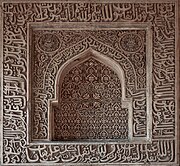




![1091 Quranic text in bold script with Persian translation and commentary in a lighter script[211]](http://upload.wikimedia.org/wikipedia/commons/thumb/a/ac/Page_from_the_Qur%27an_of_Sultan_Ibrahim_%28TKS_EH_209%29.jpg/203px-Page_from_the_Qur%27an_of_Sultan_Ibrahim_%28TKS_EH_209%29.jpg)



